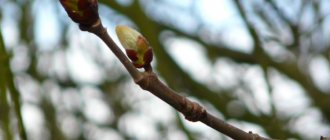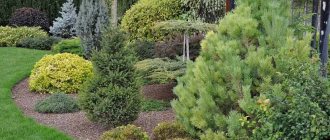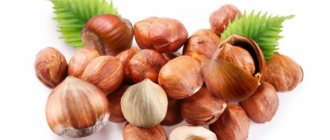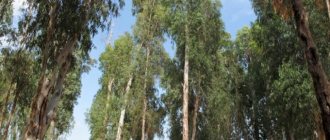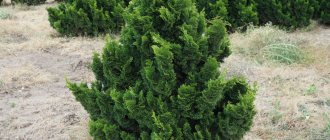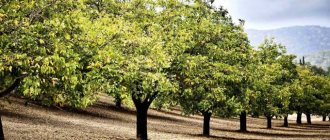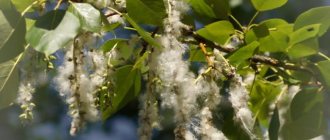The famous umbrella trees growing in the haze of the African savanna are representatives of the large Acacia genus, belonging to the Legume family. In countries further north, they have relatives with luxurious foliage, interesting wood and decorative inflorescences. This article will help you understand what different types of acacias look like, how they reproduce, when they bloom, and what medicinal properties they have.
Acacia photo
Description of the plant and species
The Greek word Acacia means "thorn". And it is not surprising, since most species of this plant are armed with many sharp thorns as protection from those who like to feast on the leaves. Most often, acacias are evergreen trees or shrubs with a height of 1.5 to 25 m and an impressive trunk diameter reaching 1.2 m. They grow very quickly, but by the age of 30 they are already aging, thinning out the crown and acquiring voluminous hollows.
Acacias are characterized by beautiful paired-pinnate leaves; in some species they are equipped with overgrown petioles - phyllodes. The spines are formed from narrow stipules. The plant usually blooms in early June and has white or brightly colored flowers collected in large inflorescences. The fruit, as befits a legume, is a legume, which varies greatly in appearance among different species.
The most interesting species of the Acacia genus include:
- silver (A. dealbata) native to Australia; its fluffy, chicken-colored staminate flowers, collected in paniculate inflorescences, are sold in March under the incorrect name "mimosa";
- black (A. melanoxylon) - also an Australian species with dark wood, which replaces walnut in the manufacture of inlaid furniture and various interior items;
- Senegal (A. senegal) - an African tree with triple curved spines, cultivated for gum arabic;
- red (A. spectabilis) – North American shrub up to 2 m high;
- Chinese (A. farnesiana) is a highly branched tree, characteristic of East Asia, with a pronounced aroma of violets.
Silver acacia is mistakenly called mimosa
What species are acacias confused with?
In the Legume family there are many trees with paired pinnate leaves. In appearance they resemble acacia, but belong to different genera. However, there is still confusion in their names that needs to be sorted out, and the Latin names of plants will help with this.
- white acacia is Robinia pseudoacacia, a large tree with rounded leaves and fragrant white flowers;
- pink acacia , also sticky, also belongs to the genus Robinia (Robinia viscosa), is distinguished by mauve flowers and the presence of glands on the pedicels and calyxes;
- Lankaran acacia - also known as Japanese, silk, Crimean mimosa and silk tree - belongs to the genus Albizia (Albizia julibrissin), cultivated for its amazingly beautiful pink flowers, collected in fluffy umbrellas, reminiscent of the crests of crowned cranes;
- yellow acacia , also known as tree-like acacia - actually caragana (Caragana arborescens), a native of Altai and Siberia, owner of large yellow flowers;
- sand acacia is a plant of the Ammodendron genus, unique for its large, dull purple flowers and ashy calyxes.
An interesting camel's tail acacia grows in Central Asia and Mongolia - in fact, it is called Caragana jubata, or maned cape. The plant looks like a brown, slightly curved column with a tuft of greenery and a rim of white flowers at the top. Similar to our heroine are species of the genus Gleditsia - luxurious, durable trees with powerful red spines and beans up to 40 cm long.
Robinia viscosa
Care
Young trees need regular moisture, while mature bushes require water only during drought. Shrub acacia takes enough moisture from incoming precipitation. For irrigation, use water at room temperature; water the planting in the morning or evening. After watering, slight loosening of the soil is necessary.
Top dressing
The plant does not require fertilizers for the first three years. Older trees are fed with special preparations during the flowering period and in mid-summer. 100 g of fertilizer is enough for one plant, which is scattered near the root and sprinkled with soil. At the end of summer, you can use 30 g of potassium sulfate or a glass of wood ash per acacia tree.
Features of care during the flowering period
The plant needs regular watering and constant sunlight. There is no need for additional spraying of the tree. The flowering period of acacia is the best time to apply fertilizers with a high content of potassium and phosphorus.
Features of care in spring
Water should not stagnate, and loosening the soil is also not recommended. You can weed around the acacia tree to remove weeds. The soil should not be drained, because the bush plant will enrich it with nitrogen on its own.
White acacia fragrant clusters
Preparing the plant for winter
Acacia is frost-resistant, it can withstand temperatures below -25 degrees, but for the first three years the bush must be covered for the winter. In the autumn season, when all the leaves have fallen and it gets colder outside, you can begin preparing for frost. Peat or fallen leaves are poured onto the root area, the tree is wrapped in burlap and secured until spring.
Beginning gardeners are still confused: is acacia a tree or a shrub? It all depends on the variety and type. The planting is in demand due to its beautiful flowers, unique fragrance and valuable red wood. When purchasing a plant, you should ask the seller for a complete description of the acacia shrub and the rules for caring for it.
Waffle iron GFgril GF-010,
1510 ₽ More details
Waffle iron GFgril GFW-015, red
2990 ₽ More details
Steamers GFgril
Spreading
Acacias are plants of the tropics and subtropics, and they settle both in arid steppes and along river banks and even in heavily humid lowlands. In the mountains they rise to a height of 1000 m. The African landscape is characterized by single, sparsely standing trees; in the east of Australia large thickets of these plants are found.
The homeland of robins, popularly known as “white acacias,” is North America. From the beginning of the 17th century, thanks to the gardener Jean Robin, they settled in European parks. Robinia prefers a warm temperate climate, but at the same time easily adapts to a wide variety of conditions, so it currently grows in Europe, New Zealand, Argentina, and some Asian countries.
Robinia appeared in Russia in the 19th century and quickly occupied the forest-steppe zone of the European part, as well as the Primorsky Territory. The root system of the plant disrupts the nitrogen cycle in the soil, so ecologists are striving to stabilize its habitat in Russia.
The above-mentioned decorative Lankaran acacia is widespread in the northern Caucasus and Crimea. It is grown from seeds, propagated by root shoots or cuttings. The species thrives in cultivation provided that winter temperatures do not fall below 8°C.
Acacia Lankaran
Reproduction
White acacia can be propagated both by seeds and root suckers. If you buy seeds in a store, remember that they remain viable for 3 years. See the deadline for implementation.
Before planting, the seeds should be soaked in hot water and left there until they cool. Wet seeds are sown in boxes to a depth of 1-2 cm. In May, the seedlings are transferred to a greenhouse. In mid-June it needs to be planted in the soil at a distance of 25 cm.
Medicinal properties and contraindications of acacia
When acacia is mentioned as a medicinal plant, they mean white robinia. Its main active ingredient is robinin glycoside. It has a hepatoprotective effect and reduces the level of nitrogenous substances in the blood during developing renal failure. More than a dozen different flavonoids have been found in the flowers of the plant, some of which are included in anti-hangover tablets.
Robinia essential oils are used in perfumery. The unripe fruits of the tree are a source of the antioxidant quercetin, and the bark contains more than 7% tannins, which are effective in the treatment of bacterial infections. When the bark is damaged, silver acacia releases gum, which consists of 76% arabana polysaccharide.
Acacia flowers are used in folk medicine due to properties such as:
- antipyretic;
- antispasmodic;
- choleretic;
- diuretic;
- astringent.
Acacia honey, almost white from Robinia and lemon yellow from Caragana receives very flattering characteristics from beekeepers, doctors and lovers. It has a restorative, sedative and antimicrobial effect when taken orally, and also heals wounds, eczema, and ulcers externally. Inhalation of an aqueous solution of honey is recommended for inflammation of the upper respiratory tract.
When using Robinia as a medicinal plant, you should remember that its seeds, bark and roots are poisonous. The root is especially dangerous because it has a similar appearance and smell to licorice. Failure to comply with dosages can lead to poisoning, accompanied by a sharp drop in blood pressure. Treatment with this plant is contraindicated for pregnant women, breastfeeding women, children under 12 years of age, and persons with individual intolerance.
It should be remembered that acacia seeds, bark and roots are poisonous
A little history
For the first time, the unique properties that acacia has were discovered by the Egyptians several thousand years ago. These people associated this tree with the beginning and end of life, as it bloomed with white and red flowers. The acacia symbolized the supreme god Ra, who was the patron of fire, and the goddess of war Neith lived on the branches of the tree.
In some countries, acacia personifies spiritual purity, and the tree is given mystical significance. People believe that acacia thorns can ward off evil spirits, so they decorate the front door with tree branches. Among the nomads living in the Arabian desert, acacia was considered sacred, so breaking off a tree branch was considered the same as inviting trouble upon oneself.
Acacia is mentioned in both Christian and Jewish scriptures. The ancient Jews considered acacia to be sacred, and Christians claim that the Great Ark and some other sacred relics were also made from acacia. In the Middle Ages, acacia oil was used for anointing and in some Christian rituals and ceremonies.
Application
Not a single type of acacia or black locust is included in the State Pharmacopoeia of the Russian Federation, but white black locust has found application in folk medicine and homeopathy. Infusions and other herbal preparations of flowers and bark of this tree are prescribed for:
- urolithiasis;
- colds;
- osteochondrosis, myositis, joint pain;
- inflammation of the large intestine, kidneys, bladder and genitals.
In homeopathy, tinctures of fresh Robinia bark are used in the treatment of migraines, flatulence, and dyspepsia.
Acacia bark tinctures are used in the treatment of many diseases.
Collection, preparation and storage
The source of the main medicinal raw material is flowering acacia. The buds that have begun to bloom are plucked from the branches, laid out on a tarpaulin and dried either under a canopy in the shade or in dryers at a maximum temperature of 50°C.
Robinia bark and leaves can be harvested from April to September. They must be dried in a thin layer and turned periodically, avoiding blackening, rotting and mold. When organizing work, the toxicity of the plant bark is taken into account: harvesters are provided with personal protective equipment, and pregnant and lactating women are not allowed to work. Robinia raw materials are stored in cardboard boxes or cloth bags for no more than three years. Containers with plant bark are marked “Poisonous!”
The source of medicinal raw materials is flowering acacia

